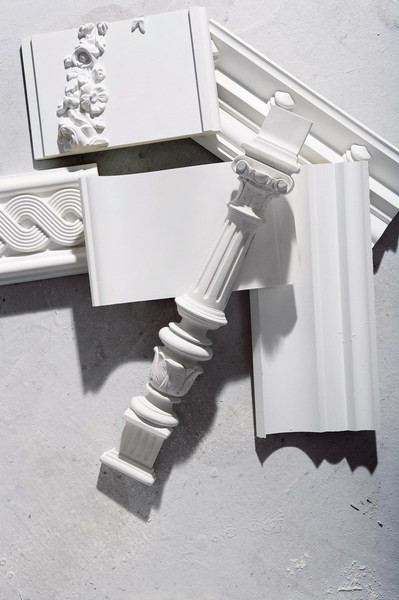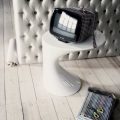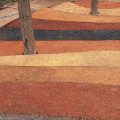Text: Oleg Shadrin. Stylist: Marina Bessonova. Photo: Dmitry Zhuravlev. Plaster productsGypsum has woken up!The production of gypsum stucco is somewhat reminiscent of the work of a baker. The quality of flour, or rather the powder obtained by grinding gypsum stone, plays an important role in this matter: the finer the grind, the stronger the molded element will be. The "filling" of vegetable and fiberglass, as well as metal reinforcement, will also help make gypsum more durable. To increase the strength, special resins can be mixed into gypsum. Thanks to them, the material, fragile by nature, will successfully compete with plastic and stone. For example, from the French gypsum of the company atelier sedap, you can cast not only wall and ceiling decorations, but also more substantial elements: fireplace mantels and even lamps. Traditional (that is, without any clever additives) gypsum can also survive for centuries. Look at the facades of historical buildings, which are decorated with stucco moldings cast two centuries ago. You simply cannot imagine a better advertisement for this material. However, it is worth looking at the other side of the coin: in addition to obvious advantages, gypsum also has noticeable disadvantages. The main problem is installation. First, a mixture of gypsum and PVA glue is applied to the surface of the stucco element, then the part is fixed to the wall with screws. Keep in mind that gypsum decor is a “weighty” thing. Even a modest-sized socket will weigh half a kilo, if not more. In general, it is problematic to cope with the fastening without the help of professionals (especially if the volume of work is large). Distributors and manufacturers of stucco moldings will gladly send you a well-trained specialist to help, not forgetting to include his services in the bill - it will increase approximately twice. Many clients who are planning to decorate an already finished interior with plaster decor are put off not even by the price, but by the mess, which is almost inevitable in such a situation. After all, before installing the decor, the surface of the ceiling or walls will have to be leveled and sanded. Plaster will continue to demonstrate its difficult nature in the future: it is afraid of moisture, so it is difficult to keep it perfectly clean. You can install such stucco in the bathroom only on condition that you cover it with a special protective compound every two years. Plaster is sensitive to chemicals - only acrylic and water-based paint are suitable for painting it.
Plaster productsGypsum has woken up!The production of gypsum stucco is somewhat reminiscent of the work of a baker. The quality of flour, or rather the powder obtained by grinding gypsum stone, plays an important role in this matter: the finer the grind, the stronger the molded element will be. The "filling" of vegetable and fiberglass, as well as metal reinforcement, will also help make gypsum more durable. To increase the strength, special resins can be mixed into gypsum. Thanks to them, the material, fragile by nature, will successfully compete with plastic and stone. For example, from the French gypsum of the company atelier sedap, you can cast not only wall and ceiling decorations, but also more substantial elements: fireplace mantels and even lamps. Traditional (that is, without any clever additives) gypsum can also survive for centuries. Look at the facades of historical buildings, which are decorated with stucco moldings cast two centuries ago. You simply cannot imagine a better advertisement for this material. However, it is worth looking at the other side of the coin: in addition to obvious advantages, gypsum also has noticeable disadvantages. The main problem is installation. First, a mixture of gypsum and PVA glue is applied to the surface of the stucco element, then the part is fixed to the wall with screws. Keep in mind that gypsum decor is a “weighty” thing. Even a modest-sized socket will weigh half a kilo, if not more. In general, it is problematic to cope with the fastening without the help of professionals (especially if the volume of work is large). Distributors and manufacturers of stucco moldings will gladly send you a well-trained specialist to help, not forgetting to include his services in the bill - it will increase approximately twice. Many clients who are planning to decorate an already finished interior with plaster decor are put off not even by the price, but by the mess, which is almost inevitable in such a situation. After all, before installing the decor, the surface of the ceiling or walls will have to be leveled and sanded. Plaster will continue to demonstrate its difficult nature in the future: it is afraid of moisture, so it is difficult to keep it perfectly clean. You can install such stucco in the bathroom only on condition that you cover it with a special protective compound every two years. Plaster is sensitive to chemicals - only acrylic and water-based paint are suitable for painting it.

Making Money with Desserts: Success Stories
Evgeniya Polischuk (Fedutinova) instagram:@evgeniyafedutinovavk.com/janeshomebaking– It all started with baking for family and friends. Gradually, I started posting photos of my baked goods on Instagram – and orders started coming in. I made my first custom-made cake on October 13, 2014, and a little earlier I started making macaroons and cupcakes. You could say that the business “found me”, I am very […]

Soups are cold recipes with photos
Cold cucumber soup with yogurt and lemonsorbet from the chef of the restaurant La Taverna Alexander Zhurkin Photo: Getty Images Ingredients: Plain yoghurt – 125 g Cucumber – 150 g Lemon/lime sorbet – 50 g Cocktail shrimp – 24 g Fresh ginger juice – 1 g Lime juice – 5 g Fresh orange juice – 5 g Parsley – 1 g Pink pepper – 1 g Watercress – […]

barbeque kebab
Pork tenderloin in glaze Photo:Dmitry Bayrak/dbstudioPreparation time: 20 minutes + marinating time.Calories: 454 kcal per serving.For 4 servings: 4 pork tenderloins (approximately 300 g each), 1 onion, 2 cloves of garlic, 1 tsp. lemon zest, 1 tsp. lemon juice, a pinch of ground cumin, coriander and turmeric, 1 tbsp. vegetable […]

Pierre Duacan: dietary recipes: Ducane diet
Beetroot soup Photo:Season’S, Luxury Hotels RepresentationYou will need:· Boiled beetroot – 60 g· Fresh cucumbers – 20 g· Red radish – 20 g· Green onions – 10 g· Egg – 1 pc.· Drinking mineral water – 200 g· Salt – 1 gPreparation:· Boil the egg and beetroot.· Grate the cucumbers, radish and part of the beetroot. Put everything […]





